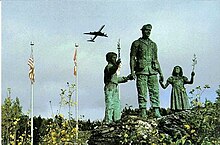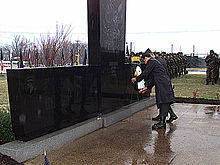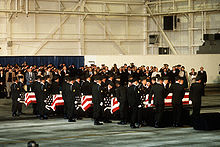Arrow Air Flight 1285R
 Illustration of DC-8-63CF N950JW | |
| Accident | |
|---|---|
| Date | December 12, 1985 |
| Summary | Icing (on board fire and possible explosion per minority report) |
| Site | Gander, Newfoundland and Labrador |
| Aircraft type | McDonnell Douglas DC-8-63CF |
| Operator | Arrow Air |
| Registration | N950JW |
| Flight origin | Cairo International Airport |
| Stopover | Cologne Bonn Airport |
| Last stopover | Gander International Airport |
| Destination | Fort Campbell |
| Passengers | 248 |
| Crew | 8 |
| Fatalities | 256 |
| Injuries | 0 |
| Survivors | 0 |
Arrow Air Flight 1285 was a McDonnell Douglas DC-8-63CF jetliner, registered N950JW, which operated as an international charter flight carrying U.S. troops from Cairo, Egypt, to their home base in Fort Campbell, Kentucky, via Cologne, Germany and Gander, Newfoundland. On the morning of December 12, 1985, shortly after takeoff from Gander en route to Fort Campbell, the aircraft stalled, crashed, and burned about half a mile from the runway, killing all 256 passengers and crew on board. [1]
The accident was investigated by the Canadian Aviation Safety Board (CASB), which determined the probable cause of the crash was the aircraft's unexpectedly high drag and reduced lift condition, most likely was due to ice contamination on the wings' leading edges and upper surfaces.[2] A minority report stated that the accident could have been caused by an onboard explosion of unknown origin prior to impact.[3]
Flight history
The aircraft, a McDonnell Douglas DC-8-63CF, was chartered to carry U.S. service personnel, all members of the 101st Airborne Division, United States Army, from a six-month deployment in the Sinai, where they had served in the Multinational Force and Observers peacekeeping mission, back to their base in Fort Campbell, Kentucky.[1] The DC-8 involved in the accident had been constructed in 1969, and had been leased to Arrow Air by its owner, International Air Leases.[4] The flight was made up of three legs, the first between Cairo and Cologne, the second between Cologne and Gander, and the third between Gander and Fort Campbell.[5] The aircraft departed Cairo at 2035 Greenwich Mean Time (GMT), and arrived at Cologne on December 12, 1985, at 0121 GMT. A new flight crew boarded the aircraft, before it departed for Gander at 0250 GMT.[5] The aircraft arrived at Gander International Airport at 0904, where passengers departed the aircraft while the aircraft was refuelled. Witnesses reported the flight engineer conducted an external inspection of the aircraft, after which the passengers reboarded the aircraft.[5]
The DC-8 began its take-off roll on runway 22 from the intersection of runway 13 at 10:15 UTC (06:45 NST). It rotated near taxiway A, 51 seconds after brake release at an airspeed of about 167 KIAS.[5] Witnesses reported the aircraft had difficulty gaining altitude after rotation; the airspeed reached 172 KIAS and began to decrease again, causing the DC-8 to descend. After crossing the Trans-Canada Highway, located about 900 feet (270 m) from the departure end of runway 22, at a very low altitude, the pitch angle increased and the aircraft continued to descend.[5] Witnesses driving on the highway said a bright glow emanated from the aircraft before it struck terrain just short of Gander Lake, and crashed approximately 900 feet (270 m) feet beyond the departure end of the runway.[5] The aircraft destroyed an unoccupied building,[6] before it broke up, causing a fire, increased in severity by the large amount of fuel aboard for the flight. All 248 passengers and eight crew aboard the aircraft sustained fatal injuries.[1][5]
Investigation
The Canadian Aviation Safety Board (CASB) investigated the crash, and, under the signature of five of nine board members, found that during its approach toward Gander, precipitation conditions were favorable for the formation of ice on the aircraft's wings. After landing, it continued to be exposed to "freezing and frozen precipitation capable of producing roughening on the wing upper surface" in addition to the freezing temperature. They also found that prior to takeoff the aircraft had not been de-iced.[7] The Board issued the following Probable Cause statement in its final report:[1][2]
The Canadian Aviation Safety Board was unable to determine the exact sequence of events which led to this accident. The Board believes, however, that the weight of evidence supports the conclusion that, shortly after lift-off, the aircraft experienced an increase in drag and reduction in lift which resulted in a stall at low altitude from which recovery was not possible. The most probable cause of the stall was determined to be ice contamination on the leading edge and upper surface of the wing. Other possible factors such as a loss of thrust from the number four engine and inappropriate take-off reference speeds may have compounded the effects of the contamination.
Four members of the CASB dissented, issuing a minority opinion asserting that there was no evidence presented proving that ice had been present on leading edges such as the wings, and the minority report speculated that:[3]
An in-flight fire that may have resulted from detonations of undetermined origin brought about catastrophic system failures.
Willard Estey, a former Supreme Court of Canada judge, submitted a review of the CASB report in 1989, ruling that the available evidence did not support either conclusion.[8] As a result the Canadian public's confidence in the CASB was undermined. The federal government responded by creating the Transportation Safety Board of Canada.[9]
Aftermath




On the day of the crash, responsibility was claimed by Islamic Jihad, a wing of Hezbollah.
The claim was dismissed by the Canadian and U.S. governments soon afterward. According to United Press International "Hours after the crash the Islamic Jihad - a Shiite Muslim extremist group - claimed it destroyed the plane to prove our ability to strike at the Americans anywhere." Pentagon and Canadian government officials rejected the claim, made by an anonymous caller to a French news agency in Beirut.[10]
256 people died including 248 U.S. servicemen and 8 crew members. As of 2009[update], that death toll constituted the deadliest plane crash in Canada.[11]
Of the 248 servicemen, all but twelve were members of 101st Airborne Division (Air Assault), most of whom were from the 3d Battalion, 502nd Infantry; eleven were from other Forces Command units; and one was an agent from the Criminal Investigations Command (CID).[12]
A memorial to the 256 victims at the crash site overlooks Gander Lake, and another memorial was erected at Fort Campbell. There is also a Memorial Park in Hopkinsville, KY, just north of Fort Campbell.
In August 2011, the Arrow Air Flight 1285 crash was featured on an episode of the television series Mayday.
See also
{{{inline}}}
- List of notable accidents and incidents on commercial aircraft
- Swissair Flight 111, the other major air disaster to occur in Atlantic Canada.
- Air Ontario Flight 1363 is a different crash, also occuring in Canada, very similar to Flight 1285.
References
- ^ a b c d Accident description at the Aviation Safety Network
- ^ a b "CASB Majority Report".
- ^ a b "CASB Minority Report".
- ^ Sandford.org
- ^ a b c d e f g Sandford.org
- ^ Sandford.org
- ^ "CASB Majority Report:Findings".
- ^ "Canada Judge Rejects New Gander Crash Probe". Los Angeles Times. 22 July 1989. Retrieved 27 August 2011.
- ^ Watson, Blair. "The Transportation Safety Board Taking centre stage to advance aviation safety." Wings at Transportation Safety Board of Canada. July/August 2008. Retrieved on September 17, 2010.
- ^ Watson, Laurie (November 6, 1988). "Errors By Crew Reportedly Cited In Gander Crash". Philadelphia Inquirer, United Press International. p. A33.
- ^ "Aviation Safety Network". Retrieved 2006-10-22.
- ^ Gough, Terrence J. (1995). "Tragedy at Gander". Department of the Army Historical Summary Fiscal Year 1986. United States Army Center of Military History.
{{cite book}}: External link in|chapterurl=|chapterurl=ignored (|chapter-url=suggested) (help)
External links
| External images | |
|---|---|
Media links:
- The VERY Suspicious 1985 Plane Crash of Arrow Air Flight 1285 in Gander, Newfoundland
- Time Magazine - The Fall of the Screaming Eagles - retrieved 28 Dec 2006
- Time Magazine - Gander: Different Crash, Same Answers - retrieved 28 Dec 2006
- Globalsecurity.org - 1989 Congressional Debates on Gander Crash - retrieved 28 Dec 2006
- Fort Campbell Courier - Gander-related news articles - retrieved 28 Dec 2006
- Gandercanada.com - Photos of the 20th Anniversary Memorial Service in Gander - retrieved 28 Dec 2006
- CBC News - Ceremonies mark anniversary of deadly Newfoundland air crash - retrieved 28 Dec 2006
- CBC News - Broken Arrow: debate continues after 20 years - retrieved 28 Dec 2006
- Rootsweb.com - List of victims - retrieved 28 Dec 2006
- Canadian Air Force - The Silent Witness Memorial in Gander - retrieved 28 Dec 2006
- Rootsweb.com - Photographs of the Gander Memorial in Hopkinsville, Kentucky - retrieved 28 Dec 2006
